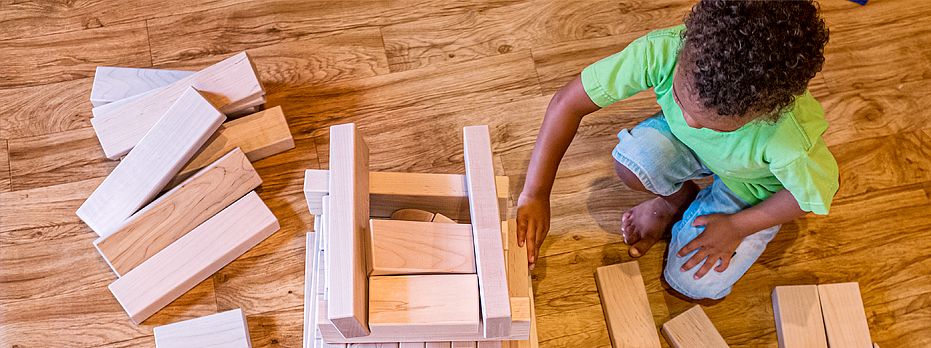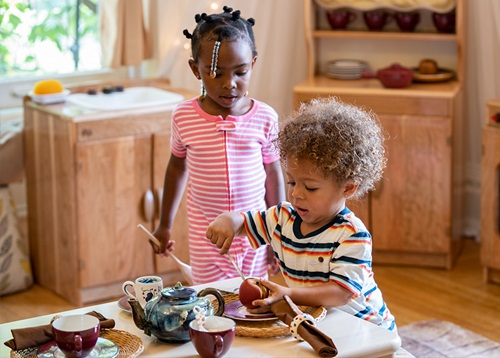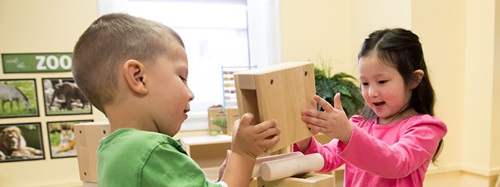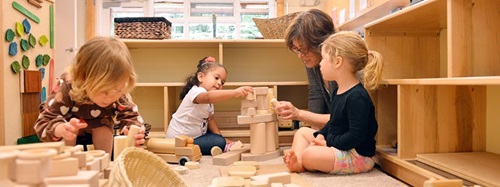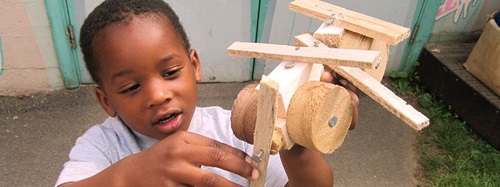Problems in the Block Corner?
| February 2005Does the sound of crashing blocks and shouting voices bring the adults at your center rushing to the block corner? If so, you might want to consider some of these tips to head off problems before they have a chance to develop.
Organize Your Space
- Provide ample, uncrowded space for several children to build together. For example, a 10’x12’ area would be suitable for up to eight preschoolers.
- Offer a sufficient number of blocks without overwhelming children. For a group of eight children, provide 200 wooden blocks for the three-year-olds and 450 wooden blocks for the five-year-olds.
- For safety and easy access, store blocks on low, open shelves. These shelves can then serve as protective dividers for the children’s constructions.
- Put props and accessories in plain view. Organize small pieces in clear plastic bins. Provide duplicates of popular items to encourage shared play.
- Install firm, smooth, low-pile carpet to provide a stable building base, to cut down on noise, and to make it more comfortable to sit on the floor.
- Place the block area in a traffic-free spot to help eliminate bumps from passersby.
Develop Rules for Working Safely and Cooperatively
- Help children understand that girls as well as boys need to have an equal opportunity to play in the block area.
- Treat blocks respectfully—no crashing, throwing, dropping, stepping on, or hitting. These actions are dangerous and can chip and splinter the wood. Don’t mark up blocks—tape signs on blocks instead.
- To help cut down on accidental crashes, build at least 12 inches away from the front of shelves and construct away from others’ structures.
- Determine how high it is safe to build. Maybe children should build just as high as shoulder height with heavy wooden blocks. Or maybe they should be encouraged to use only light cardboard blocks for very tall structures.
- Always ask permission to touch someone else’s constructions or use their blocks.
- Young builders often hoard blocks. Take only what is needed at the time.
- Establish which materials can be brought into the area (dress-up hats—yes, water—no). Determine whether blocks can be removed from the block area.
Provide Adequate Time
- If block building is offered daily, children learn to plan and are relaxed with the materials rather than hoarding them. They are not apt to overcrowd the center as they often do with special event activities.
- Allow a block of uninterrupted time for play so that constructions may develop. Older preschoolers often need 45 minutes to plan and build.
- Give advance warning so children can decide how to end their block play.
- Allocate sufficient clean-up time so that this task can be fun and educational, rather than rushed and disagreeable.
Arrange Positive Clean-Up Sessions
- Older builders may wish to leave a special project standing to continue the next day. Help them add a sign or protective device to preserve their construction.
- Decide in advance whether everyone will help clean up or only those who played with the blocks.
- To facilitate the clean-up process, create variously shaped block outlines on the shelves for the children to match. For safety, have them place the small blocks on the top shelves and the larger, heavier ones on the bottom shelves. Vehicles and accessories should be placed in a nearby space separate from the blocks.
- Develop fun, rapid clean-up systems—human assembly lines, use of toy transport vehicles, calling out shapes or sizes, etc.
What Is Your Role?
- Be an encourager and guide. Emphasize the process rather than showing a concern for a final product.
- Listen to, acknowledge, and support your children’s ideas. Respect their suggestions and encourage them to value one another’s viewpoints.
- Arouse curiosity. Ask open-ended questions that begin with "What if?" or "Why do you suppose?"
- Encourage experimentation. Let your children know that it is all right to take a guess or try a new idea.
- Observe carefully to see how you can facilitate the construction process. Provide or add special materials when needed.
- Turn a mistake into a learning experience. Help your children analyze why an idea did not work out.
- Promote discussion, interaction, and collaboration. As your children work together, help them to be patient and persistent in their explorations.
Turn Problems Into Opportunities
If, in spite of following these suggestions, things go awry in the block corner, seize the moment and turn a situation into a positive problem-solving opportunity. Help children develop their critical and creative thinking skills and foster their social and physical development.
Here are steps you can take with your children when determining problems, developing solutions, and putting those solutions into action:
- Identify—Determine and discuss the problem.
- Brainstorm—Encourage children to think about possible solutions.
- Select—Help children examine advantages and disadvantages of solutions. Choose one that seems workable.
- Explore and Implement—Let your children gather the necessary materials and resources. Try the solution they decided upon.
- Evaluate—Observe and discuss whether the solution to the problem was successful. If it didn’t work, encourage them to try other solutions.
Assist your children as they stretch their thinking skills while learning to solve their own problems in the block area. This helps lay an important foundation for your children’s lifelong problem-solving skills.

